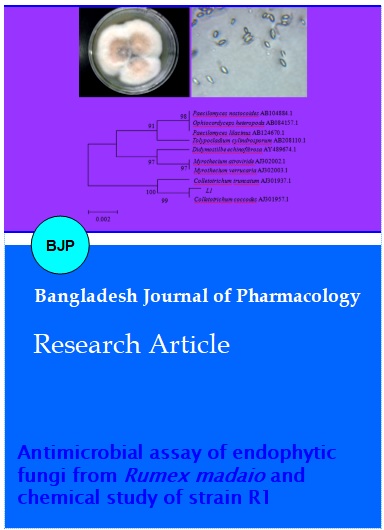Antimicrobial assay of endophytic fungi from Rumex madaio and chemical study of strain R1
DOI:
https://doi.org/10.3329/bjp.v14i3.41598Keywords:
Antimicrobial, Endophytic fungi, Rumex madaioAbstract
In order to search more antimicrobial natural products for new drug discovery, bioassay and chemical investigation of endophytic strains from Rumex madaio were carried out. Six fungal strains (numbered as L1, L6, L9, L10, R1, R2) were successfully isolated and their antimicrobial effects on three human pathogens, Escherichia coli, Staphyloccocus aureus and Candida albicans, were evaluated. The results indicated that ethyl acetate extracts of fermentation broth of these strains had no potent antimicorbial activity against E. coli and C. albicans while strains L1 and R1 had stronger inhibitory effects on S. aureus. On basis of morphological characteristics and 18S rRNA sequence analysis, strains L1 and R1 were respectively classified as Colletotrichum and Fusarium geni. The chemical study of strain R1 led to isolation of two known antimicrobial agents, dibutyl phthalate (1) and beauvericin (2).
Video Clip of Methodology:
1 min 14 sec: Click to watch
Downloads
194
139 Supplementary File
87 Read
32

Downloads
Published
How to Cite
Issue
Section
License
Authors who publish with this journal agree to the following terms:
- Authors retain copyright and grant the journal right of first publication with the work simultaneously licensed under a Creative Commons Attribution License that allows others to share the work with an acknowledgement of the work's authorship and initial publication in this journal.
- Authors are able to enter into separate, additional contractual arrangements for the non-exclusive distribution of the journal's published version of the work (e.g., post it to an institutional repository or publish it in a book), with an acknowledgement of its initial publication in this journal.
- Authors are permitted and encouraged to post their work online (e.g., in institutional repositories or on their website) prior to and during the submission process, as it can lead to productive exchanges, as well as earlier and greater citation of published work (See The Effect of Open Access).
